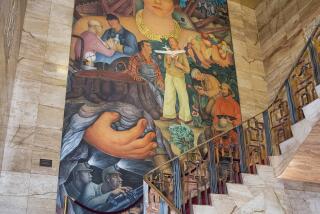Op-Ed: Serra’s fall may further ‘whiten’ America’s already too-white history

Father Junípero Serra is fast losing ground in the literal and figurative American landscape. Statues of the missionary have been destroyed, removed or tagged for potential banishment up and down the state. On Wednesday, after hours of debate stretching over several evenings, the Ventura City Council voted to remove an iconic Serra statue that in one form or another had stood in the city center since 1936.
The fall of the founder of California’s missions should surprise no one. For generations, a divide has been growing between the historical Serra — who devoted himself to the universalism of Catholicism, the suppression of individualism, and the renunciation of worldly things — and the modern state of California to which his legacy is bound.
Add to those incongruities a heightened awareness of the harm that indigenous people endured in the missions — where Franciscans assaulted their cultures and where diseases battered their communities — and it is no wonder that reminders of Serra’s life and work provoke pain, anger and calls for removal, especially in a time of fervent demands that those in power (now and in the past) be held accountable for their wrongs.
And yet, we should consider what will be lost if his image and name disappear from the public square. If we cancel Serra, we could further “whiten” American history, or at least the part of it we popularize. Paradoxically, the desire to erase Serra may play into the hands of racists and white nationalists who seek to define America only in their own image.
Serra has endured until now as an icon in California because generation after generation of Catholic and civic leadership projected upon his likeness values deemed timeless and worthy of veneration. Soon after his death, he was exalted by his co-religionists as the agent of a fearsome god, a miracle worker and a man of supreme virtue. Others recast him as a promoter of agriculture, a protector of Native Americans, a Washington-esque Founding Father, and a humble immigrant from south of the border. In 2015, Pope Francis canonized him, making him the United States’ first Hispanic saint.
Today, the mostly magical shapeshifting that kept Serra popular has lost its power. For many, he is just another unaccountable Columbus, a symbol of all the horrors inflicted on indigenous peoples since the onset of Spanish colonization 250 years ago.
Some facts from the historical record are in order. Serra worked tirelessly to save indigenous souls for Christ. To that end, he sought the eradication of most elements of native culture, and he condoned corporal punishment. But he did not promote, practice or celebrate the killing of native Californians.
Nevertheless, tens of thousands of indigenous Californians died from disease in the missions that Serra initiated. The powers he secured from the Spanish viceroy in Mexico City are sometimes characterized as a Native American Bill of Rights, yet they mainly strengthened the missionaries’ control in California and diminished the military’s. Serra protected native Californians from unscrupulous settlers and soldiers, and he opposed the execution of resistance leaders. But he was no human rights activist. In Serra’s age, human rights as a concept did not exist, and he didn’t preach that all people were born free, equal in dignity, rights, and before the law.
The record also shows that Serra (and other Spanish colonists) deserves a place in our understanding of American history. If by banishing Serra we obscure that fact, we not only falsify the narrative, we lose the opportunity to compare two threads of our heritage. Most of the Protestant colonizers who led the European settlement of the East Coast, for example, could not conceive of sharing their world with people they dismissed as “savages”; hence their destructive, even genocidal actions. Serra went to war with native beliefs, but he never intended that the land should be swept of indigenous peoples.
The United States’ historical landscape is already too white, too English and too Protestant to convey the complexity and diversity of our national origins. Of the thousands of Spanish-speaking padres, soldiers and settlers who came to the Americas, nearly all have been forgotten, losers not so much in the contest for territory as in the subsequent battle with the heroes of the Revolutionary War and architects of the Constitution for a place in the American imagination.
Calls for Serra’s cancellation can reinforce outdated notions that the settlement of North America was a natural, pre-ordained, westward-moving Protestant tide, even though much of the continent from Florida to California was colonized by Spanish-speaking Catholics who came north from the Caribbean or what is now Mexico. The cultures and religion of these pobladores and their descendants shape our land in lasting ways. Monuments to Serra have served as useful — if flawed and insensitive — markers for Hispanic contributions to a diverse national fabric.
Time is most likely up for Serra’s statues. Their removal should be a reckoning for those inclined to wrongly romanticize the mission era. However, we must consider not only what will replace Junípero Serra but how his absence may oversimplify our nation’s past. This is no mere academic debate. How we understand our history, who we celebrate and condemn, can have doleful consequences for our national definition of citizenship, our political rights and who does or doesn’t get to be American.
UC Riverside professor of history Steven W. Hackel is the author of “Children of Coyote, Missionaries of St. Francis: Indian-Spanish Relations in Colonial California 1769-1850” and “Junípero Serra: California’s Founding Father.”
More to Read
A cure for the common opinion
Get thought-provoking perspectives with our weekly newsletter.
You may occasionally receive promotional content from the Los Angeles Times.






